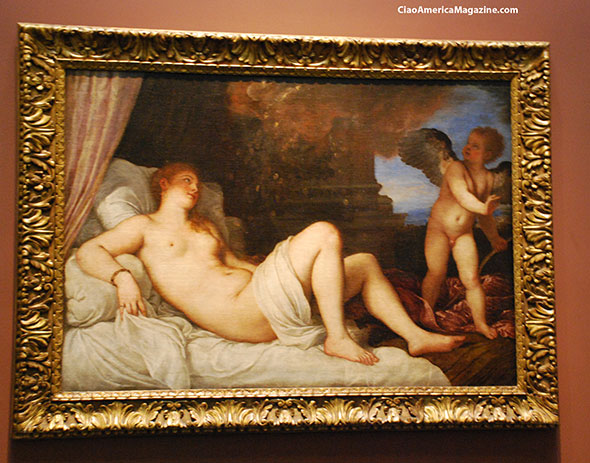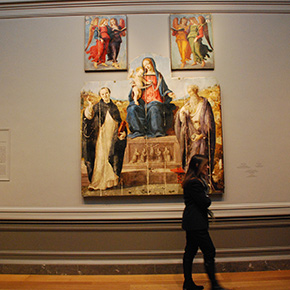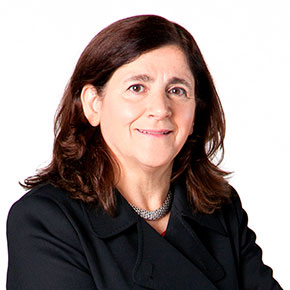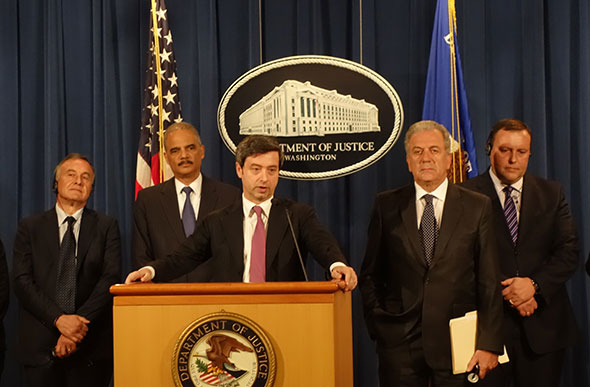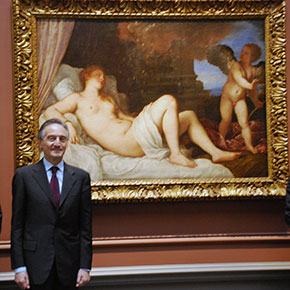Author Archives: CiaoAmerica
Piero di Cosimo: The Poetry of Painting in Renaissance Florence
The first major retrospective exhibition ever presented of paintings by the imaginative Italian Renaissance master Piero di Cosimo (1462–1522) premieres at the National Gallery of Art, Washington, this Sunday, February 1 through May 3, 2015. Piero di Cosimo: The Poetry of Painting in Renaissance Florence will showcase some 44 of the artist’s most compelling works. With themes ranging from the pagan to the divine, the works include loans from churches in Italy and one of his greatest masterpieces, Madonna and Child Enthroned with Saints Elizabeth of Hungary, Catherine of Alexandria, Peter, and John the Evangelist with Angels (completed by 1493), from the Museo degli Innocenti, Florence. Several important paintings will undergo conservation treatment before the exhibition, including the Gallery’s Visitation with Saints Nicholas of Bari and Anthony Abbot (c. 1489–1490)—one of the artist’s largest surviving works.
“We are delighted to share the brilliance of Piero di Cosimo—the Renaissance’s most spellbinding storyteller—with our visitors,” said Earl A. Powell III, director, National Gallery of Art, Washington. “This is also the first time the Galleria degli Uffizi in Florence has co-organized a paintings exhibition with another museum and we look forward to many more projects with our Italian partners.”
After Washington, a different version of the exhibition, including work by Piero’s contemporaries, will be on view at the Galleria degli Uffizi, Florence from June 23 through September 27, 2015, entitled Piero di Cosimo (1462–1522): Pittore fiorentino “eccentrico” fra Rinascimento e Maniera.
“No artist has given the world more rare and singular inventions while remaining in the shadow of the Renaissance greats of his time than Piero di Cosimo,” said Cristina Acidini, Superintendent of Cultural Heritage for the City and the Museums of Florence. “His beguiling pictorial creations will linger in the imagination of all those who see the exhibition.”
“Una iniziativa unica nel suo genere, di grandissimo prestigio – ha commentato l’Ambasciatore d’Italia a Washington Claudio Bisogniero – che conferma lo straordinario rapporto di collaborazione tra la National Gallery e il sistema museale italiano, grazie anche all’opera del Ministero degli Esteri italiano e della nostra Ambasciata. Per citare alcuni recenti esempi, penso alla mostra del David Apollo dal Museo Nazionale del Bargello e del Galata Morente dai Musei Capitolini che hanno rispettivamente aperto e chiuso il 2013 – Anno della Cultura Italiana negli Stati Uniti, la mostra della Danae di Tiziano dal Museo di Capodimonte per celebrare il semestre di Presidenza italiana dell’UE, e alla serie innumerevole di concerti, mostre, proiezioni di film che organizziamo costantemente con questo grande museo americano”.
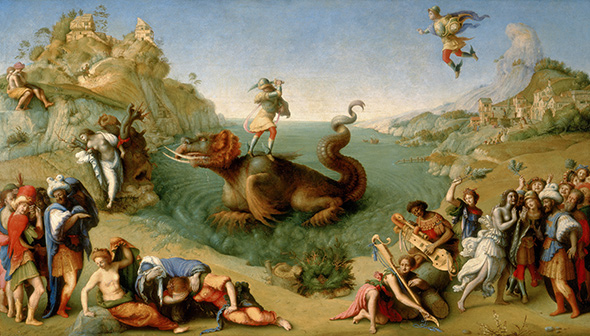
Piero di Cosimo, Liberation of Andromeda, c. 1510-1513
Galleria degli Uffizi, Florence
Alinari / Art Resouce, NY
SOURCES: NGA, IT-EMB
War & Art. Destruction and Protection of Italian Cultural Heritage During World War I
During the First World War even Italy’s historical and artistic heritage became a powerful propaganda tool for the country affected by the war. The art and beauty destroyed during air raids or land battles were further proof of the “enemy’s barbarity.” The planned or accidental destruction of artistic monuments had already been condemned by France on Sept. 19, 1914, following the irreparable damages to Reims Cathedral, and even earlier, on Aug. 25, 1914, by Belgium when the historical library of Louvain was destroyed by fire.
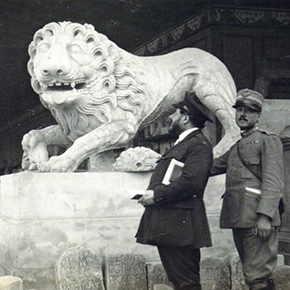
Paul Adams of the Journal visiting the Museum in Aquileia, accompanied by the journalist Ugo Ojetti, 1916
Centuries-old art became an innocent victim of the war’s destruction. Stone sculptures could not survive steel shells.
In Italy, the destruction of culture was considered a cowardly and uncivilized act, a sort of blasphemous sacrilege, much like the violence perpetrated by invading armies against unarmed civilians. The idea that Italy’s national heritage could be used as a successful propaganda tool against the enemy was immediately put into action with photographs, like those in this special exhibition, that documented the damages of war to paintings, frescoes and churches. Photography was also used to sensitize the population in remote areas far from the front lines since this visual means proved the most effective instrument of persuasion—it could be easily understood even by the less educated members of the population and the illiterate. Newspapers and magazines thus detailed the beautiful artworks in the more famous Italian cities protected and defended against the “enemy’s barbarity.”
As shown in the exhibition, the photographs taken to document the protection of the art became art themselves. The sandbag walls and wooden structures built around precious sculptures and architectural features became art in themselves.
This exhibition, shown outside of Italy for the first time, has been organized by Istituto Per La Storia Del Risorgimento Italiano, Roma, the Embassy of Italy, Washington D.C., and the Italian Cultural Institute of Chicago.
Photographic exhibit at the Kansas City (MO), National World War I Museum at Liberty Memorial
November 18th, 2014 | February 17th, 2015
SOURCE: NATIONAL WORLD WAR I MUSEUM AT LIBERTY MEMORIAL
Addio Mario!
Mourners pay final respects to Mario Cuomo. Photo: @reuterspictures http://t.co/xdERDzldlx pic.twitter.com/vL10tkb9Ia
— TIME.com (@TIME) January 6, 2015
At National Museum of Women in the Arts, Picturing Mary: Woman, Mother, Idea
Landmark exhibition explores images of Virgin Mary by renowned Renaissance and Baroque artists.
Appearing throughout the entire world, her image is immediately recognizable. In the history of Western art, she was one of the most popular subjects for centuries. On view Dec. 5, 2014–April 12, 2015, Picturing Mary: Woman, Mother, Idea, is a landmark exhibition at the National Museum of Women in the Arts (NMWA), bringing together masterworks from major museums, churches and private collections in Europe and the United States. Iconic and devotional, but also laden with social and political meaning, the image of the Virgin Mary has influenced Western sensibility since the sixth century.
Picturing Mary examines how the image of Mary was portrayed by well-known Renaissance and Baroque artists, including Botticelli, Dürer, Michelangelo, Pontormo, Gentileschi and Sirani. More than 60 paintings, sculptures and textiles are on loan from the Vatican Museums, Musée du Louvre, Galleria degli Uffizi, Palazzo Pitti and other public and private collections—many exhibited for the first time in the United States.
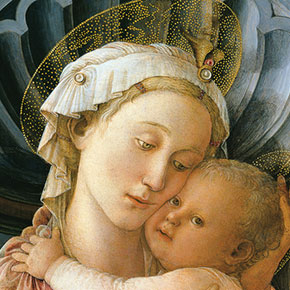 “Among the most important subjects in Western art for more than a millennium was a young woman: Mary, the mother of Jesus. Her name was given to cathedrals, her face imagined by painters and her feelings explored by poets,” said exhibition curator and Marian scholar Monsignor Timothy Verdon, director, Museo dell’Opera del Duomo, Florence, Italy. “This exhibition will explore the concept of womanhood as represented by the Virgin Mary, and the power her image has exerted through time, serving both sacred and social functions during the Renaissance and Baroque periods.”
“Among the most important subjects in Western art for more than a millennium was a young woman: Mary, the mother of Jesus. Her name was given to cathedrals, her face imagined by painters and her feelings explored by poets,” said exhibition curator and Marian scholar Monsignor Timothy Verdon, director, Museo dell’Opera del Duomo, Florence, Italy. “This exhibition will explore the concept of womanhood as represented by the Virgin Mary, and the power her image has exerted through time, serving both sacred and social functions during the Renaissance and Baroque periods.”
Picturing Mary is the newest project in an ongoing program of major historical loan exhibitions organized by NMWA, including An Imperial Collection: Women Artists from the State Hermitage Museum (2003) and Royalists to Romantics: Women Artists from the Louvre, Versailles, and other French National Collections (2012). In addition to illustrating the work of women artists, NMWA also presents exhibitions and programs about feminine identity and women’s broader contributions to culture. Picturing Mary extends, in particular, the humanist focus of Divine and Human: Women in Ancient Mexico and Peru, a large-scale exhibition organized by NMWA in 2006.
Art Basel Miami Beach 2014
Art Basel’s 13th edition in Miami Beach closed today, Sunday, December 7, 2014, amidst strong praise from gallerists, private collectors, museum groups and the media. Highlights of the show included the introduction of the new Survey sector, which brought 13 art-historical projects to the fair, including many rare works never before exhibited in an art fair context; and Art Basel’s staging with performa of Ryan McNamara’s ‘MEƎM 4 Miami: A Story Ballet About the Internet’ at the Miami Grand Theater. Solid sales were reported across all levels of the market and throughout the run of the show.
Featuring 267 leading international galleries from 31 countries, the show – whose Lead Partner is UBS – attracted an attendance of 73,000 over five days. Attendees included representatives of over 160 museum and institution groups from across the world – and a surging number of new private collectors from the Americas, Europe and Asia.
Following a 100 percent reapplication rate for the Galleries sector and with new galleries coming from across the world, the list of exhibitors was the strongest to date in Miami Beach, firmly solidifying the show’s position as the leading international art fair of the Americas.
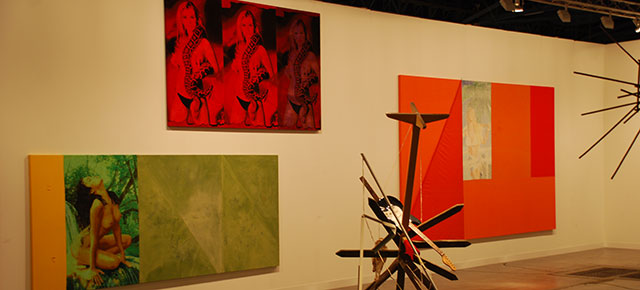
Never to forget: The Monongah Mine Disaster, December 6, 2014
They came to Monongah, West Virginia, from some of the poorest regions of Italy– Abruzzo, Calabria, Campania–to work the coal mines. Like the millions of Italians who migrated to “L’america” in search of a brighter future, most had no idea of the challenges they would face. The promise of a financed voyage and a secure job was an incentive that few could resist. But none, one suspects, could
have imagined that they would end up working in conditions as inhumane as in those in the mines of Monongah. Yet, they left their homes in Frosolone, Roccamandolfi, Duronia, San Giovanni in Fiore, Castrovillari, Canistro, and dozens of other Italian towns and came in droves to Monongah.
One hundred and two years ago, on December 6, 1907, an explosion ripped through the Monongah mines, shaking the earth as far as eight miles away, and killing, according to contemporaneous official records, 362 miners. It was, and remains, the worst mining disaster in American history. Officially, 171 Italians died that day. But those figures may underestimate the number of miners working that day; often young boys who assisted their fathers were not always “officially” counted. According to one newspaper story, it is possible that an estimated 956 lives were lost in the explosion.
(Note that this article was written on the occasion of the 100th Anniversary of the Monongah mine disaster)
Lido Civic Club of Washington DC to Host Annual Past Presidents Night, November 22, 2014
The Lido Civic Club of Washington, DC will honor their Woman and Man of the Year for 2015. They are Gracia Martore, President and Chief Executive Officer of Gannett Co., Inc. and Joseph A. Martore, President & Chief Executive Officer of CALIBRE Systems Inc. The Lido Civic Club will also honor Gene Dodaro, Comptroller General of the United States, with the National Public Service Award
The Lido Civic Club of Washington, DC, an 85 year old Italian and American civic and charitable organization, will be honoring this Saturday, November 22, 2014, at the Italian Embassy, a dynamic Italian-American couple as their Man and Woman of the Year for 2015. They are Gracia Martore, President and Chief Executive Officer of Gannett Co., Inc. and Joseph A. Martore, President & Chief Executive Officer of CALIBRE Systems Inc. The Lido Civic Club will also be honoring Gene Dodaro, Comptroller General of the United States, with the National Public Service Award.
Gracia Martore became CEO of Gannett in October 2011. Ms. Martore is the chairman and president of Gannett Foundation which supports non-profit activities in the communities which Gannett serves. The Foundation invests in the future of the media industry, encourages employee giving, reacts to natural and other disasters and contributes to a variety of charitable causes. Ms. Martore champions and actively participates in USA WEEKEND’s annual Make A Difference Day, the nation’s largest day of community service.
Joe Martore joined CALIBRE in March 2004 as part of its acquisition of Strategic Management Initiatives, Inc. (SMI), which he co-founded and served as President & CEO. In addition to his corporate responsibilities, Mr. Martore serves as a principal consultant to the U.S. Army. Mr. Martore currently is a member of the MIT Engineering Systems Division Alumni Advisory Council, and serves on the Boards of Directors for the Professional Services Council (PSC), the Fairfax County Chamber of Commerce, Easter Seals Serving DC | MD | VA, and the Laurel Grove School Museum Association.
Gene L. Dodaro is the eighth Comptroller General of the United States and head of the U.S. Government Accountability Office (GAO). As Comptroller General, Mr. Dodaro helps oversee the development and issuance of hundreds of reports and testimonies each year to various committees and individual Members of Congress. These and other GAO products have led to hearings and legislation, billions of dollars in taxpayer savings, and improvements to a wide range of government programs and services.
“We look forward to honoring these three outstanding individuals who have given much to our community and who make us all proud of our Italian heritage,” said Francesco Isgro, President of the Lido Civic Club.
“We are honored to host Lido Civic Club of Washington DC at our Embassy for the Annual Past Presidents Night – said Ambassador of Italy to the U.S. Claudio Bisogniero – This organization enjoys a great tradition in keeping Italian heritage alive among Italian Americans in the D.C. area and beyond, and in supporting Italian culture and the study of Italian language especially among young generations”.
About the Lido Civic Club: The Lido Civic Club is an Italian-American organization serving the Washington metropolitan area since 1929. Through the Lido Civic Club Charities, Inc. a 501(c)(3) non-profit foundation, it has awarded $417,000 in scholarships to Italian-American students in the area. The Lido Club also funds Italian cultural programs, supports wounded warriors, and performs other philanthropic activities in the Washington D.C. area and beyond. Lido has no paid staff and does not employ or retain lobbyists.
Italian Justice Minister Andrea Orlando Meets U.S. Attorney General Eric Holder
Italian Minister of Justice Andrea Orlando,who is in Washington DC to participate in the EU-US meeting on justice and Home Affairs (JHA), met today with his counterpart U.S. Attorney General Eric Holder, at the U.S Department of Justice. At a press conference, Orlando stressed the collaboration between the U.S. and Europe noting in particular the collaboration in fighting cyber crimes, organized crime, and terrorism. Orlando also stressed Europe’s concerns over privacy rights. Of more of an immediate concerns to U.S. and Europe, Orlando said that collaboration across Atlantic is a “pilastro fondamentale” for global security. U.S. Attorney General Eric Holder soted that his Department is sending a high-level prosecutor to the Balkans region to help coordinate efforts to prevent foreign fighters from joining terrorist groups. “These personnel will provide critical assistance to our allies in order to help prosecute those who have returned from the Syrian region bent on committing acts of terrorism,” said Holder. Also speaking at the press conference was EU Commissioner for Migration, Home Affairs and Citizenship Dimitris Avramopoulos.
Piero Coming to Washington in 2015
The first major retrospective exhibition ever presented of paintings by the imaginative Italian Renaissance master Piero di Cosimo (1462–1522) will premiere at the National Gallery of Art, Washington, from February 1 through May 3, 2015. Piero di Cosimo: The Poetry of Painting in Renaissance Florence will showcase some 40 of the artist’s most compelling works. With themes ranging from the pagan to the divine, the works include loans from churches in Italy and one of his greatest masterpieces, Madonna and Child Enthroned with Saints Elizabeth of Hungary, Catherine of Alexandria, Peter, and John the Evangelist with Angels (completed by 1493), from the Museo degli Innocenti, Florence.
“We are delighted to share the brilliance of Piero di Cosimo—the Renaissance’s most spellbinding storyteller—with our visitors,” said Earl A. Powell III, director, National Gallery of Art, Washington. “This is also the first time the Galleria degli Uffizi in Florence has co-organized a paintings exhibition with another museum and we look forward to many more projects with our Italian partners.”
After Washington, a different version of the exhibition, including work by Piero’s contemporaries, will be on view at the Galleria degli Uffizi, Florence from June 23 through September 27, 2015, entitled Piero di Cosimo (1462–1522): Pittore fiorentino “eccentrico” fra Rinascimento e Maniera.
The exhibition is organized by the National Gallery of Art, Washington, and the Galleria degli Uffizi, Soprintendenza Speciale per il patrimonio storico, artistico, ed etnoantropologico e per il Polo Museale della città di Firenze.
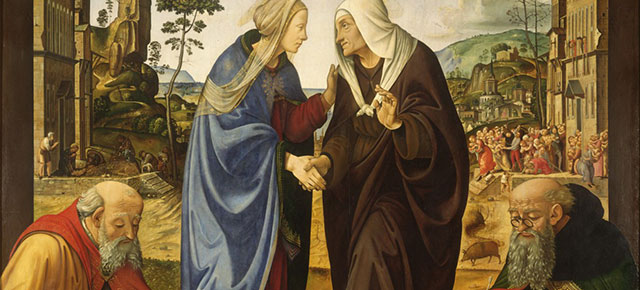 The exhibition is supported by Sally Engelhard Pingree and The Charles Engelhard Foundation. The Exhibition Circle of the National Gallery of Art provided additional funding.
The exhibition is supported by Sally Engelhard Pingree and The Charles Engelhard Foundation. The Exhibition Circle of the National Gallery of Art provided additional funding.
Salvatore Scarpitta: Traveler
In Washington DC, at the Hirshhorn, July 17, 2014 to January 11, 2015 (Lower Level)
A fascinating and singular figure in postwar art, Salvatore Scarpitta (1919–2007) created a powerful body of work that ranges from nonobjective abstraction to radical realism. Scarpitta’s career linked the worlds of art and car racing, moving from the avant-garde cultural circles of postwar Rome to the banked dirt oval speedways of rural Maryland and Pennsylvania. Focusing on his shaped and wrapped canvases, race cars, and sleds, Salvatore Scarpitta: Traveler illuminates themes that occupied the artist throughout his life: risk, movement, death, and rebirth. Deeply admired in Europe where he began his career, Scarpitta has yet to be fully recognized in his native United States. This will be the first solo presentation of his work at an American museum in over a decade, and the first ever on the East Coast.
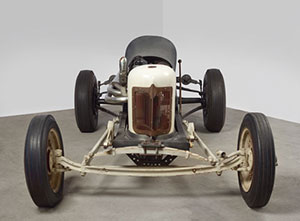 A free public opening takes place Thursday, July 17, from 7 p.m. to 10:30 p.m. Galleries open at 7:30 pm, providing the public their first opportunity to view Salvatore Scarpitta: Traveler. A competitive sprint car will be parked on the Plaza, where Scarpitta driver Greg O’Neill talks about racing at 8 pm. Hirshhorn assistant curator Melissa Ho leads an exhibition tour at 9 pm. The documentary “Art & Racing: The Work and Life of Salvatore Scarpitta” screens continuously throughout the evening. Barbecue and beer will be available for purchase on the Plaza. The other exhibitions on the museum’s Lower Level, Black Box: Oliver Laric and Directions: Jeremy Deller, will also be open.
A free public opening takes place Thursday, July 17, from 7 p.m. to 10:30 p.m. Galleries open at 7:30 pm, providing the public their first opportunity to view Salvatore Scarpitta: Traveler. A competitive sprint car will be parked on the Plaza, where Scarpitta driver Greg O’Neill talks about racing at 8 pm. Hirshhorn assistant curator Melissa Ho leads an exhibition tour at 9 pm. The documentary “Art & Racing: The Work and Life of Salvatore Scarpitta” screens continuously throughout the evening. Barbecue and beer will be available for purchase on the Plaza. The other exhibitions on the museum’s Lower Level, Black Box: Oliver Laric and Directions: Jeremy Deller, will also be open.
RELATED PROGRAMS
Scarpitta in Context: Germano Celant and Paul Schimmel in Conversation takes place Wednesday, October 8, at 7 pm in the Ring Auditorium. Co-curator of the 2012 retrospective Salvatore Scarpitta at the Galleria Civica d’Arte Moderna e Contemporanea in Turin and a personal friend of the artist for decades, Celant is artistic director of the Prada Foundation and senior curator of contemporary art at the Solomon R. Guggenheim Museum. Schimmel is former chief curator of the Museum of Contemporary Art, Los Angeles and organizer of Destroy the Picture: Painting the Void, 1949–1962, which included early works by Scarpitta. He also knew the artist well, having first met Scarpitta in the 1970s.
“Salvatore Scarpitta: Traveler” is made possible in part with the generous support of Buzz Beler, the Holenia Trust, and the Hirshhorn Exhibition Fund. The exhibition brochure is generously underwritten by Kristin and Howard Johnson and the Italian Cultural Institute
Salvatore Scarpitta: Traveler is made possible in part with the generous support of the Estate of Frank B. Gettings, in memory of Nancy Kirkpatrick and Frank Gettings; C.P. Beler, the Holenia Trust, and the Hirshhorn Exhibition Fund. The exhibition brochure is generously underwritten by Kristin and Howard Johnson and the Italian Cultural Institute on the occasion of Italy’s Presidency of the Council of the European Union from July 1 through December 31, 2014.
SOURCE: Hirshhorn
Titian’s Danaë in Washington inaugurates Italy’s Presidency of the Council of the European Union
The Danaë (1544-45) by Titian, one of the masterpieces that best represents the Italian Renaissance, marked the inauguration today, in the nation’s capital, of the Italian Presidency of the Council of the European Union. Representatives of the U.S. administration, members of the diplomatic corps, and the press gathered at the National Gallery of Art, where the work will be on exhibit until November 2.
“The Italian Presidency of the cycle coincides with a new institutional framework within the European Union and will have as its priority economic growth and the creation of new jobs,” noted Italian Ambassador to the U.S. Claudio Bisogniero. “The term will also be important,” he added, “in strengthening the partnership between Europe and the USA, for example, as regards the TTIP negotiations, the future transatlantic agreement on trade and investment.”
“We are delighted to host a masterpiece such as the Danaë ,” declared Franklin Kelly, Deputy Director of the National Gallery of Art, who also pointed out that the Gallery has the largest Titian collection in the United States.
The event was organized by the Italian Embassy in Washington and the National Gallery of Art, in collaboration with the Museo di Capodimonte in Naples, which loaned the work of art, and the Superintendence for the National Museums System of Naples and the Caserta Royal Palace. The exhibition, part of the Italy in US campaign (italyinus.org), was made possible by the generous contribution of Intesa Sanpaolo and the collaboration of the Berlucchi and Ferrero Groups.
The Danaë exhibition is the first in a series of events in the U.S. organized by the Italian Embassy in Washington to celebrate Italy’s semester at the Presidency of the European Union (italia2014.eu). From now through December 2014, events are planned not only in the fields of art and culture, but also as related to the economy, innovation, science, and public diplomacy. Among these activities is a conference on “Employment, Growth, and Quality Jobs: a Transatlantic Discussion” at the Peterson Institute that will compare the economic strategies of Europe and the U.S. and a series of meetings on the 450th anniversary of Galileo Galilei.
